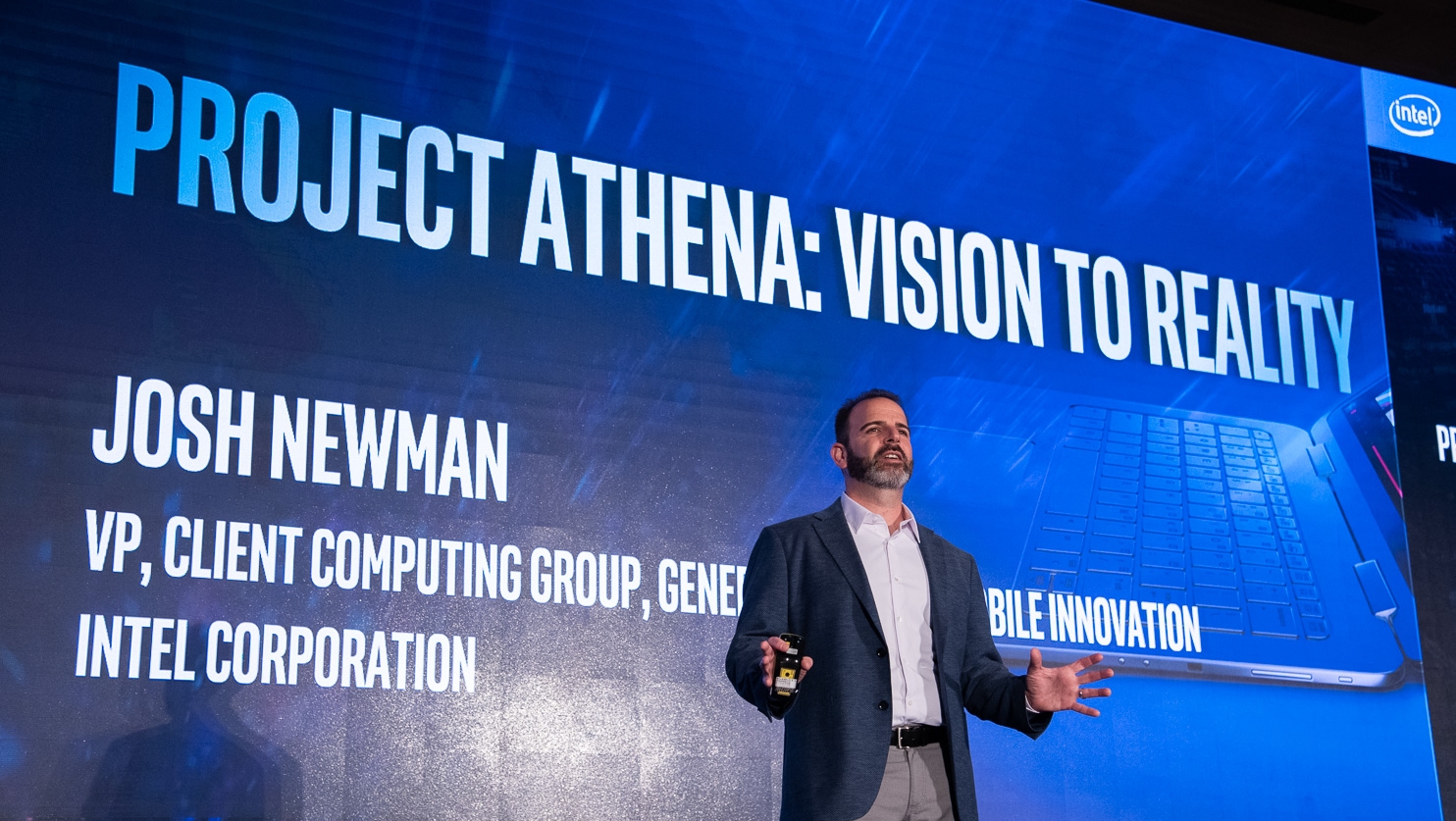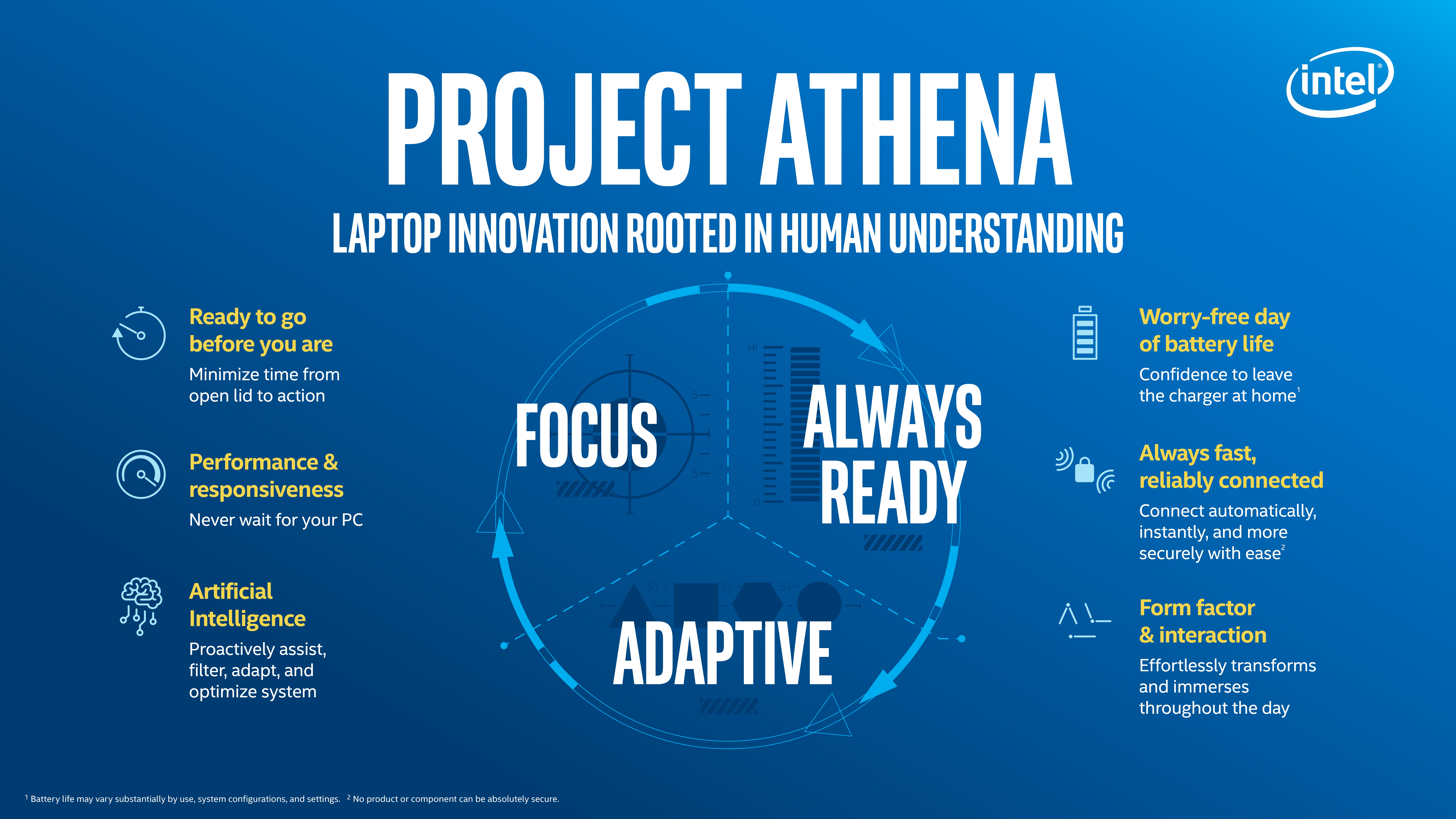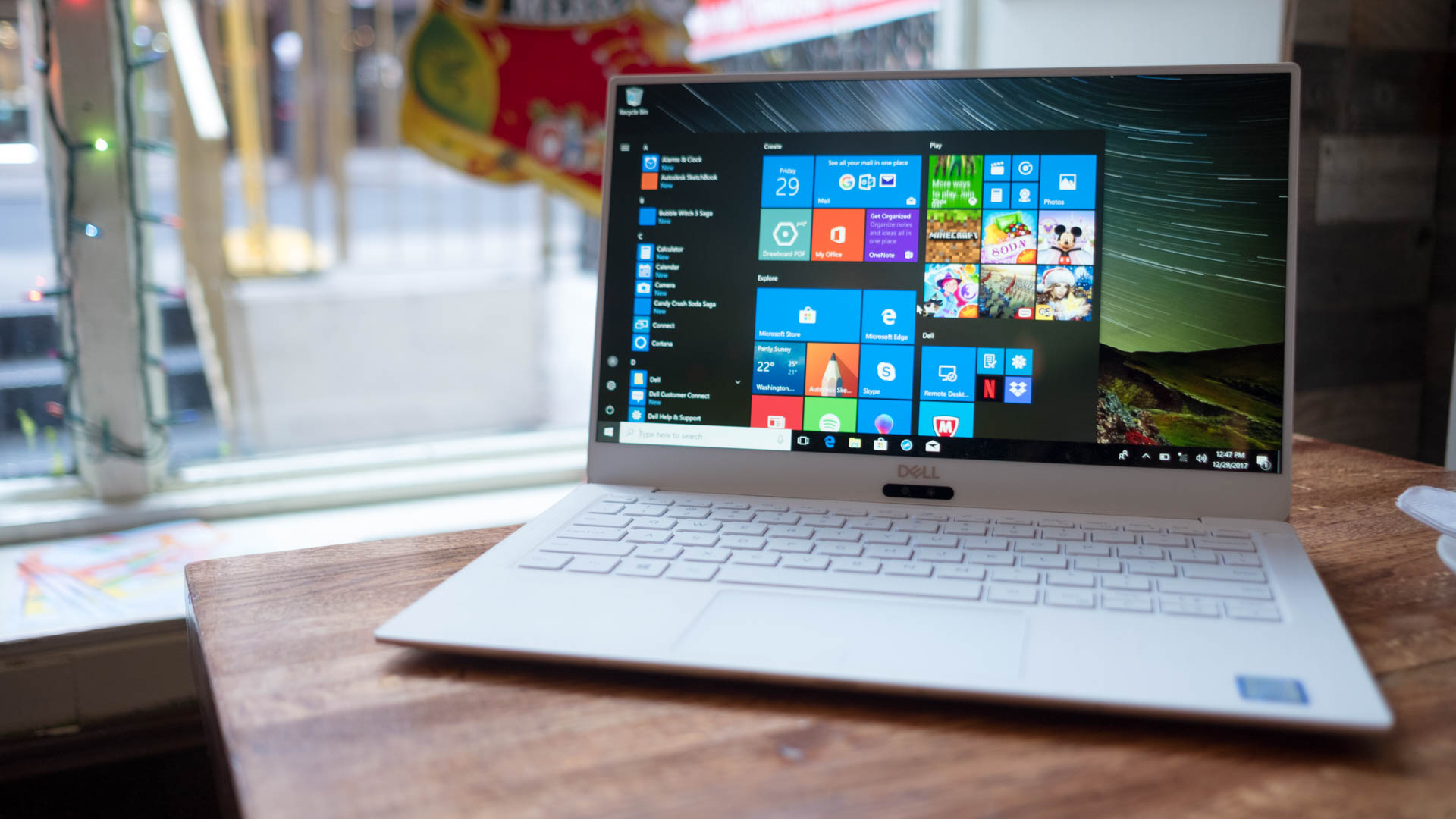Intel Project Athena: everything we know about Intel Evo
Intel's Project Athena is now Intel Evo

Intel's Project Athena is an innovation program created by the chipmaker to aid laptop makers build the revolutionary laptops of the future.
Announced at CES 2019, Project Athena sees Intel working with some of the biggest names in the laptop industry – including Acer, Asus, Dell, Google, HP, Lenovo, Microsoft and Samsung – to craft the next generation of laptops that are thinner, lighter and more powerful, as well as have lightning fast connectivity, a system that wakes from sleep in a flash and battery life that will last all day.
If that sounds like a mythical invention to you, just take a look at the HP Elite Dragonfly, a Project Athena-certified 2-in-1 laptop that’s under 1kg in weight and has a battery life that lasts more than 24 hours on a single charge.
It's somewhat akin to what Intel and laptop manufacturers did with Ultrabooks some years back. By coming up with a list of minimum specifications that laptops would have to meet to be known as Ultrabooks, consumers know they are getting the very latest – and greatest – hardware.
With Project Athena laptops, Intel and its partners are seeking to make devices that can handle the demands of modern-day computing. It’s a very big deal, and we at TechRadar, for one, cannot wait to see the kind of laptops that this grand program will result in.
Here are the news and rumors we've gathered together, and everything else we know so far about Intel's Project Athena.

Cut to the chase
- What is it? A partnership between Intel and manufacturers to design the next generation of laptops
- When is it out? Possibly late 2019
- What will it cost? Project Athena laptops will vary in price, but don't expect them to be cheap
What is Intel Project Athena?
Intel Project Athena is a laptop design initiative that sees Intel work even more closely with a number of laptop manufacturers to help reinvent the future of laptops.
Get daily insight, inspiration and deals in your inbox
Sign up for breaking news, reviews, opinion, top tech deals, and more.
Many people also consider Project Athena as Intel's way of battling the growth of Windows 10 on ARM devices, and laptops running on Qualcomm Snapdragon hardware. These devices offer always-on connections and remarkably long battery life, but don't use Intel hardware.
While Windows 10 on ARM devices have excelled at battery life, start-up times and always-on connectivity thanks to built-in 4G LTE support, they have so far been unsuccessful in offer decent performance that’s comparable to Intel-powered laptops.

Project Athena will see Intel offer guidance to equipment and PC component manufacturers to create future laptops that are smarter, faster (thanks to 5G) and more power efficient – which will likely mean much longer battery life.
Intel has also revealed at the Project Athena Ecosystem Symposium event in Taipei, Taiwan that it will open three global Project Athena Open Labs facilities – two in Taipei and Shanghai, one in Folsom, California – in order to work with manufacturers and test their laptops to ensure they meet Project Athena's specifications. These labs started operating in June 2019.
Josh Newman, Intel vice president and general manager of PC Innovation Segments, Client Computing Group, said that "Project Athena Open Labs are a critical step in enabling more extensive, day-to-day collaboration with the components ecosystem to continuously raise the bar for innovation across the platform."
Intel has also revealed how Project Athena "creates a path forward to accelerate laptop innovation" through:
- An annual spec outlining platform requirements
- New user experience and benchmarking targets defined by real-world usage models
- Extensive co-engineering support and innovation pathfinding
- Ecosystem collaboration to accelerate key laptop component development and availability
- Verification of Project Athena devices through a comprehensive certification process
Intel Project Athena release date
Intel has implied that initial Project Athena laptops could release as early as the second half of 2019. However, if that's the case, then we wouldn't expect to see any Project Athena-certified laptops until very late this year.
Since the Project Athena Open Labs didn’t launch until June, the early Project Athena laptops that we could see in 2019 will likely be Intel-made reference devices that will offer consumers and manufacturers a taste of what Project Athena laptops will be capable of.
According to Intel, "the next wave of Project Athena designs" will come in "2020 and beyond," so expect to see Project Athena laptops from manufacturers, like Asus and Acer, next year.

Intel Project Athena price
Currently, we don't have any information on what sort of prices Project Athena laptops will sell for. However, that’s never stopped us from making a few educated guesses before.
Considering the target spec and features of Project Athena laptops (which we'll get to in a moment), it's possible that these are going to be high-priced laptops.
Intel's Ultrabook initiative, which was similar to Project Athena in the fact that it saw Intel working with laptop makers to develop laptops that met clear design and specification criteria, resulted in high-end machines with premium price tags. It's not too much of a stretch, therefore, to think that Project Athena laptops will be pitched at the high-end in terms of hardware and price.
If we do see Intel-made Project Athena laptops this year, with the third-party Athena laptops following in 2020, then that’s another hint that the first wave of Project Athena laptops will be quite pricey.
However, when third-party Athena laptops launch, prices could potentially become more affordable, as there will be more competition between the companies.
It seems likely that Project Athena laptops will be pitched as alternatives to Windows on ARM laptops, like the HP Envy x2. Those ARM laptops have prices around $1,000/£1,000/AU$1,500, so it won’t be surprising if Project Athena laptops will tout that price point as well.

However, before you get too dismayed about being unable to afford an Intel Project Athena laptop, there are some clues that suggest we may see more affordable Athena-certified laptops as well.
For a start, Intel has talked about how Project Athena will cover a range of laptop types. It's also been announced that some Athena laptops will run Windows 10 and Chrome OS. Coupled with the fact that Google is one of the Project Athena partners, it looks like we'll be getting Project Athena Chromebooks.
Since Chromebooks are generation a lot cheaper than traditional laptops, they may provide a cheaper way to partake in some of that Project Athena goodness.
Intel Project Athena specifications
Intel has recently released the specifications for Project Athena, and it is comprised of 15 responsiveness metrics and 3 battery life metrics. All 23 of these metrics are aimed at creating the next generation of laptops it has envisioned.
Based on these specifications, Intel will determine whether each laptop model is up to snuff. When it does, it gets Intel’s “Engineered for mobile performance” seal of approval, which essentially tells consumers that it’s a Project Athena certified device.
- Ready to go before you are: Project Athena laptops must, first and foremost, boast Modern Connected Standby or Lucid Sleep, as well as offer either fingerprint scanning or face recognition biometric login. In addition, laptops must wake from sleep in less than one second.
- Performance & responsiveness: Laptops must have a Core i5 or Core i7 processor with more than 8GB DRAM, and at least 256GB SSD storage space, with Intel Optane memory as an option. In addition, they must have consistent responsiveness on battery.
- Adaptive intelligence: Laptops that meet Project Athena specifications must also support Far Field voice service for voice commands, as well as OpenVINO AI on PC WinML.
- Worry-free battery life: Laptops must also boast 16+ hours of battery life for local video playback or 9 or more hours for real-world use. In addition, they’re supposed to offer 4 hours of battery life after less than 30 minutes of charging.
- Always fast, reliably connected: In terms of connectivity, laptops must boast Thunderbolt 3 and WiFi 6 Gig+ – not to mention, offer Gigabit LTE as an option.
- Form factor & interaction: Last but not least, these devices must boast an ultra slim 2-in-1 or clamshell for factor touting a 12- to 15-inch touch display with 1080p or better resolution and 3-side narrow bezel. They must also have a backlit keyboard, precision touchpad and pen support.
Intel Project Athena features
To release a laptop as part of Project Athena, manufacturers will have to meet certain features and specifications. While we haven’t gotten our hands on a definitive list just yet, here are the features we know will be part of Project Athena.
5G connectivity: One of the chief features of Project Athena will be 5G connectivity. This means that every Project Athena laptop will come with the capability to connect to 5G cellular networks (via a SIM card).
5G will offer speeds far in excess of 4G, and 5G-equipped laptops will allow access to the internet without needing to connect to Wi-Fi. This is not only more convenient – as you'll be able to check your emails and browse the web from pretty much anywhere that has 5G network coverages – but also more secure, as you won’t have to rely on open Wi-Fi networks.
The speed boosts promised by 5G could also allow us to use our Athena laptops in exciting new ways like streaming 4K content or playing games on services such as Nvidia GeForce Now and Google Stadia, which utilize remote PCs to power games that are streamed to your device.
Longer battery life: Improving the battery life on laptops has been a constant struggle for manufacturers. With laptops getting thinner than ever, the space to add batteries is shrinking as well. With laptops getting more powerful – and more power-hungry – laptop makers have to carefully balance maximizing battery life without throttling performance.
Project Athena intends to drastically improve battery life of laptops, with times between charges of around 9 hours, a lot longer than many modern Intel-based laptops.
True, Snapdragon-based laptops have seen battery life figures of beyond 24 hours, which makes the 9 hours aim a bit less impressive. It's worth noting, however, that Snapdragon-based laptops have considerably poorer performance.
If Project Athena results in laptops that perform well and have long battery life, then Intel could be on to a winner.
Instant-on: No one likes waiting around for our laptops and PCs boot up Windows. Smartphones and tablets have spoiled us when it comes to devices that power up almost instantly. So, Project Athena is aiming to bring that to Windows-based laptops and Chromebooks with Intel hardware inside.
Again, Windows on ARM devices already accomplish this, and they also remain connected even in sleep mode. Emails continue to be downloaded, for example, so when you open up the laptop, your emails are already there, waiting for you.
We hope – and expect – for Project Athena to offer similar functionality.
Intel hardware: We also expect Intel to set minimum hardware specifications, such as including SSD storage and support for Wi-Fi 6, the latest wireless networking technology.
By setting these minimum specifications, Project Athena laptops will guarantee some of the latest and most cutting-edge technology available.
- Can't wait? Here's our pick of the best Ultrabooks of 2019

Matt is TechRadar's Managing Editor for Core Tech, looking after computing and mobile technology. Having written for a number of publications such as PC Plus, PC Format, T3 and Linux Format, there's no aspect of technology that Matt isn't passionate about, especially computing and PC gaming. He’s personally reviewed and used most of the laptops in our best laptops guide - and since joining TechRadar in 2014, he's reviewed over 250 laptops and computing accessories personally.